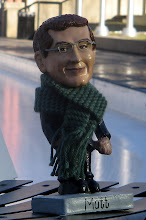Matching familiar pieces like the Beethoven with modern, unfamiliar works tends to turn up interesting connections. John Adams is obviously aware of the German symphonic tradition - his piece's title is a German word, meaning a book of harmonies, with connotations of winds. The middle movement, "The Anfortas Wound" alludes to Wagner's opera Parsifal - it begins with a little reference to Wagner and builds from there. The first movement was inspired by a dream of a huge tanker ship lifting out of the sea and flying through the air - this was according to our conductor this week, Alisdaire Neale - and the third movement is also inspired by an improbable flight. Its title, "Meister Eckhart and Quackie", refers to another German, a Christian mystic of the 14th century, and Quackie is Adams' young daughter's nickname. Adams had envisioned the two of them flying together in a hot air balloon, or maybe that's just what I envision when I listen to this music.
Music can't really be "about" flying or tanker ships or 14th century Christian mystics, of course - the closest it can get is to make clear allusions to other music that we associate with those things, as in the Parsifal movement. Still, Harmonielehre is remarkable for its exhilarating, airy quality, and the way that soaring, expressive melodies are combined with hypnotic minimalist figurations - a lot of it reminds me of an Indonesian gamelan orchestra, actually. The New Grove dictionary says about Adams' style in this piece:
He fused repetitive motifs with a lush, highly expressive 19th-century symphonic language. Informed by dreams, Jungian analysis, mystical poetry and transcendentalist writings, compositions such as these established his reputation as a composer of 'accessible' scores that provided relief to audiences wary of contemporary music.
The other American piece on the program, Kevin Puts' Vespertine Symphony, is similarly accessible to wary audiences, and may even sound eerily familiar to listeners of the Icelandic singer/songwriter Bjork. Puts (pronounced as in "she puts down the gun", not "what a putz") uses melodies from Bjork's album Vespertine, creating a soaring, lush, and highly expressive language of his own. Mr. Puts has been around this week to help guide our rehearsals of his piece; the New World Symphony was originally going to play the piece in an earlier version last fall, before those concerts were preempted by Hurricane Ivan.

Mike, Doug, and Jeff try some unfamiliar stools

Our section is joined this week by three guest bass players, Mike Fuller, Jeff Lehnberg, and Doug Nestler. I already knew Mike from a music festival in Verbier, Switzerland; he is now playing in Chicago's Civic Orchestra. This week was my first time meeting both Jeff and Doug, though Doug and I both studied with Don Palma in Boston. It's been fun playing with all three of these guys, and sharing ideas and comments with them in preparation for the upcoming Met audition.


 Technorati Link Count: no. of blog reactions to this post
Technorati Link Count: no. of blog reactions to this post
No comments:
Post a Comment